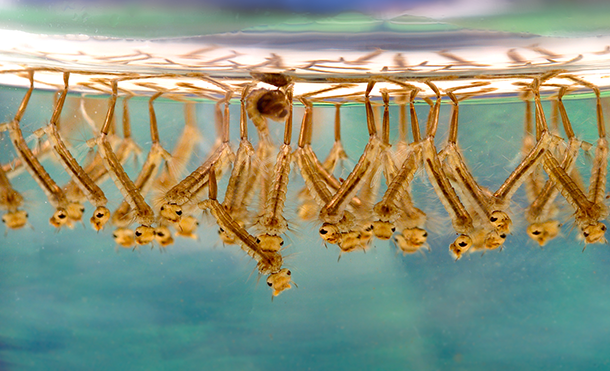Squashing the Mosquito Population
Air Date: Week of July 17, 2015

The larvae of Culex mosquitoes make dense groups in standing water. A shift in the feeding behavior of those mosquitoes helps explain the rising incidence of West Nile virus in North America. (Photo: Image: James Gathany/CDC, CC BY 2.5)
Partially thanks to human activities, mosquitoes have been able to migrate across oceans and throughout the globe. Now, researchers, scientists and entrepreneurs are harnessing drone technology, genetic modification and disease databases to significantly reduce population numbers, and predict possible disease outbreaks.
Transcript
CURWOOD: Modern lab tools can give humans a leg up on these annoying insects as well – and already six million genetically modified male mosquitoes have been released to fight dengue fever in Brazil. When these modified males mate, they pass on a gene that kills the larvae and within six months the native mosquito population was reduced by 95 percent in a test area. That’s according to a report in the Public Library of Science journal, Neglected Tropical Diseases.
And another new initiative, this one from Microsoft, called “Project Premonition” aims to use drones to deliver mosquito traps to remote and rugged areas. There they can capture the troublesome creatures, and supply specimens to analysts looking to spot new disease outbreaks and potential epidemics.
Links
Modified mosquitoes begin blitz on dengue in Brazilian city
Study: nearly all offspring of modified male mosquitoes die
Project Premonition aims to use mosquitoes, drones, cloud computing to prevent disease outbreaks
Living on Earth wants to hear from you!
Living on Earth
62 Calef Highway, Suite 212
Lee, NH 03861
Telephone: 617-287-4121
E-mail: comments@loe.org
Newsletter [Click here]
Donate to Living on Earth!
Living on Earth is an independent media program and relies entirely on contributions from listeners and institutions supporting public service. Please donate now to preserve an independent environmental voice.
NewsletterLiving on Earth offers a weekly delivery of the show's rundown to your mailbox. Sign up for our newsletter today!
 Sailors For The Sea: Be the change you want to sea.
Sailors For The Sea: Be the change you want to sea.
 The Grantham Foundation for the Protection of the Environment: Committed to protecting and improving the health of the global environment.
The Grantham Foundation for the Protection of the Environment: Committed to protecting and improving the health of the global environment.
 Contribute to Living on Earth and receive, as our gift to you, an archival print of one of Mark Seth Lender's extraordinary wildlife photographs. Follow the link to see Mark's current collection of photographs.
Contribute to Living on Earth and receive, as our gift to you, an archival print of one of Mark Seth Lender's extraordinary wildlife photographs. Follow the link to see Mark's current collection of photographs.
 Buy a signed copy of Mark Seth Lender's book Smeagull the Seagull & support Living on Earth
Buy a signed copy of Mark Seth Lender's book Smeagull the Seagull & support Living on Earth

